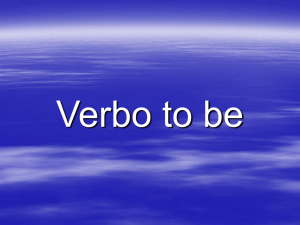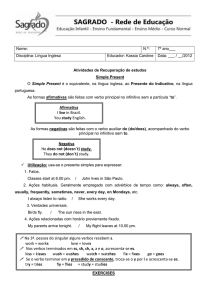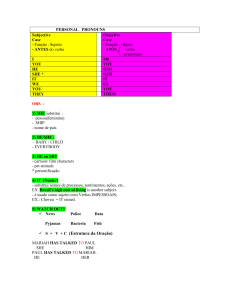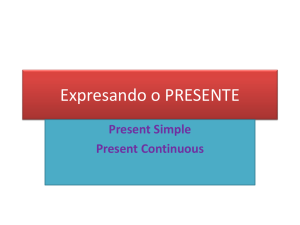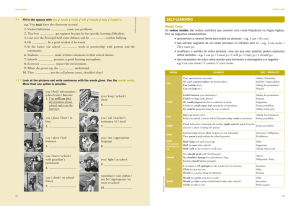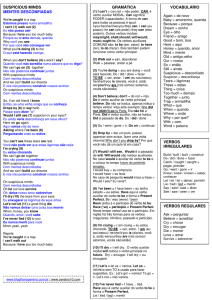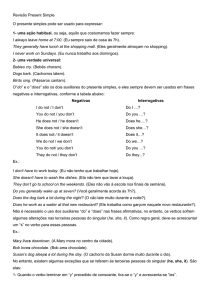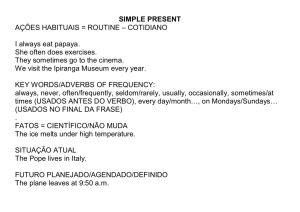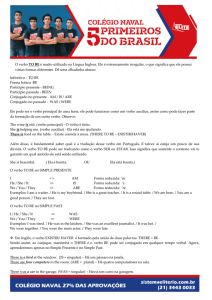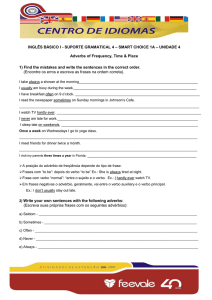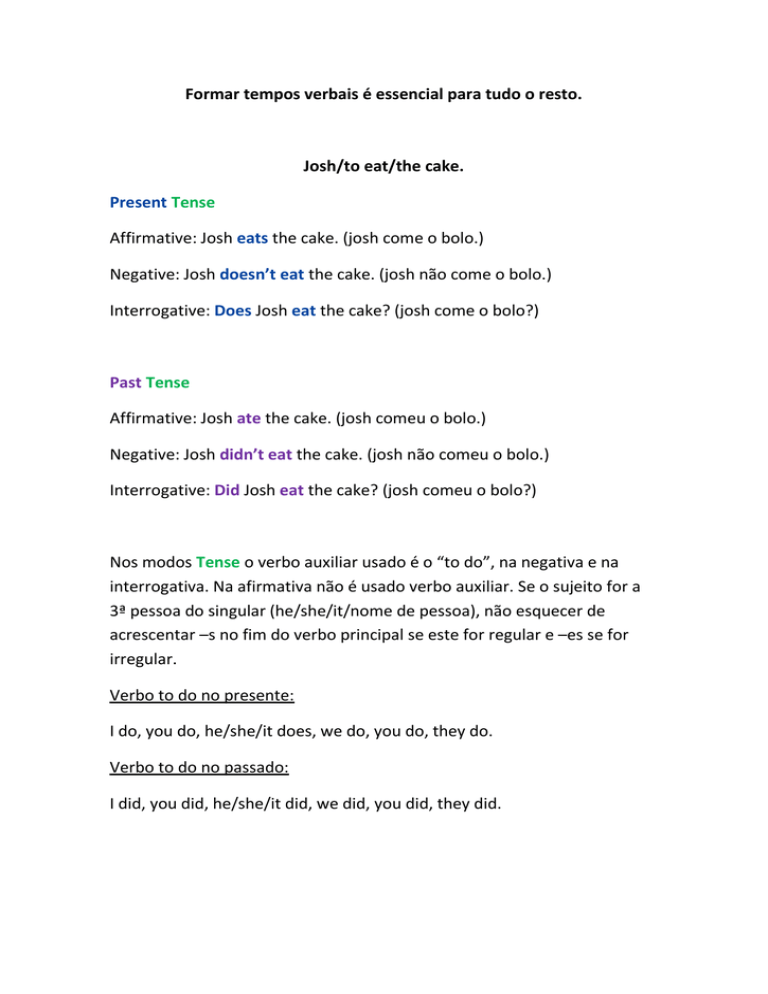
Formar tempos verbais é essencial para tudo o resto.
Josh/to eat/the cake.
Present Tense
Affirmative: Josh eats the cake. (josh come o bolo.)
Negative: Josh doesn’t eat the cake. (josh não come o bolo.)
Interrogative: Does Josh eat the cake? (josh come o bolo?)
Past Tense
Affirmative: Josh ate the cake. (josh comeu o bolo.)
Negative: Josh didn’t eat the cake. (josh não comeu o bolo.)
Interrogative: Did Josh eat the cake? (josh comeu o bolo?)
Nos modos Tense o verbo auxiliar usado é o “to do”, na negativa e na
interrogativa. Na afirmativa não é usado verbo auxiliar. Se o sujeito for a
3ª pessoa do singular (he/she/it/nome de pessoa), não esquecer de
acrescentar –s no fim do verbo principal se este for regular e –es se for
irregular.
Verbo to do no presente:
I do, you do, he/she/it does, we do, you do, they do.
Verbo to do no passado:
I did, you did, he/she/it did, we did, you did, they did.
Present Continuous
Affirmative: Josh is eating the cake. (josh está a comer o bolo.)
Negative: Josh isn’t eating the cake. (josh ñ está a comer o bolo.)
Interrogative: Is Josh eating the cake? (josh está a comer o bolo?)
Past Continuous
Affirmative: Josh was eating the cake. (josh estava a comer o bolo.)
Negative: Josh wasn’t eating the cake. (josh não estava a comer o bolo.)
Interrogative: Was Josh eating the cake? (josh estava a comer o bolo?)
Nos modos Continuous o verbo auxiliar usado é o “to be”, em todos os
tempos. Ao verbo principal acrescenta-se sempre a terminação –ing.
Verbo to be no presente:
I am, you are, he/she/it is, we are, you are, they are.
Verbo to be no passado:
I was, you were, he/she/it was, we were, you were, they were.
Present Perfect
Affirmative: Josh has eaten the cake. (josh tem comido o bolo.)
Negative: Josh hasn’t eaten the cake. (josh não tem comido o bolo.)
Interrogative: Has Josh eaten the cake? (josh tem comido o bolo?)
Past Perfect
Affirmative: Josh had eaten the cake. (josh tinha comido o bolo.)
Negative: Josh hadn’t eaten the cake.(josh não tinha comido o bolo.)
Interrogative: Has Josh eaten the cake? (josh tinha comido o bolo?)
Nos modos Perfect, é usado o verbo auxiliar “to have” em todos os
tempos. O verbo principal é sempre transformado em particípio passado
(past participle –PP).
Verbo to have no presente:
I have, you have, he/she/it has, we have, you have, they have.
Verbo to have no passado:
I had, you had, he/she/it had, we had, you had, they had.
Alguns PP’s: seen (to see), done (to do), made (to make), ran (to run)…
Ter em conta: nas frases interrogativas o verbo auxiliar vem sempre antes
do sujeito. Em caso de dúvida de conjugação de verbo principal, ver tabela
de conjugação de verbos do livro!
Future (esqueci-me de falar deste! É importante para saberes as ifclauses)
Affirmative: Josh will eat the cake. (Josh comerá o bolo.)
Negative: Josh won’t eat the cake. (Josh não comerá o bolo.)
Interrogative: Will Josh eat the cake? (Josh comerá o bolo?)
Neste modo é apenas usado o verbo modal auxiliar “will” e o verbo
principal mantém-se no infinitivo SEM “to”.
Verbo will na afirmativa:
I will, you will, he/she/it will, we will, you will, they will.
Verbo will na negativa:
I won’t, you won’t, he/she/it won’t, we won’t, you won’t, they won’t.
Conditional (tmb é importante para as if-clauses!)
Affirmative: Josh would eat the cake. (Josh comeria o bolo.)
Negative: Josh wouldn’t eat the cake. (Josh não comeria o bolo.)
Interrogative: Would Josh eat the cake? (Josh comeria o bolo?)
É apenas usado o verbo modal auxiliar “would” e o verbo principal tmb se
mantém no infinitivo sem “to”.
Verbo would na afirmativa:
I would, you would, he/she/it would, we would, you would, they would.
Na negativa:I wouldn’t, you wouldn’t, he/she/it wouldn’t, we wouldn’t,
you wouldn’t, they wouldn’t.
Forma estas frases nas 6 formas (present tense, past tense, present
continuous, past continuous, present perfect, past perfect)
-Cassie/to make/the bed.
-You/to decide/to become a nun.
-Nick and Leen/to celebrate/the wedding.
-I/to scream/for help.
Voz ativa e voz passiva (active and passive voices)
Active voice (frase no passado – past tense)
I gave icecream to the dog. (eu dei gelado ao cão.)
Passive voice:
Icrecream was given to the dog by me. (foi dado gelado ao cão por mim.)
Ou
The dog was given icecream by me. (este tipo de frase não faz sentido em
português, mas pode ser usado em frases que têm complemento direto e
indireto em inglês porque faz tanto sentido como a primeira utilização.)
Outro exemplo (frase no presente – present tense)
I throw the ball. (eu atiro a bola)
I = subject (sujeito)
Throw = verb (verbo)
The ball = Object (complemento direto pois responde á pergunta “o
quê”. O que é que foi atirado? A bola.)
Neste caso, a voz passiva fica: The ball is thrown (verbo auxiliar no
PRESENTE e verbo principal no PP) by me.
Agora juntamos um complemento indireto.
I throw the ball to my sister. (atiro a bola à minha irmã.)
My sister = complemento indireto pois responde à pergunta “a quem”. A
quem é que a bola foi atirada? Á minha irmã. Temos agora um sujeito (I),
um verbo (throw), um complemento direto (the ball) e um indireto (my
sister).
Neste caso é possível transformar a frase para a passiva de acordo com as
duas opções:
The ball is thrown to my sister by me.
Ou seja, complemento direto + verbo auxiliar no tempo correspondente
+ verbo principal no PP + complemento indireto + agente da passiva
OU
My sister is thrown the ball by me.
Ou seja, complemento indireto + verbo auxiliar no tempo
correspondente + verbo principal no PP + complemento direto + agente
da passiva.
Isto é só uma troca do lugar dos complementos. Tudo o resto se mantém
igual!
NÃO ESQUEÇER QUE NA PASSIVA O VERBO PRINCIPAL FICA SEMPRE NO
PP!
Vamos tentar esta frase em todos os tempos.
Past Tense:
Active: I threw the ball to my sister.
Passive: The ball was thrown to my sister by me. OU My sister was
thrown the ball by me.
Present Continuous:
Active: I am throwing the ball to my sister.
Passive: The ball is being thrown to my sister by me. OU My sister is
being thrown the ball by me.
Past Continuous:
Active: I was throwing the ball to my sister.
Passive: The ball was being thrown to my sister by me. OU My sister was
being thrown the ball by me.
Present Perfect:
Active: I have thrown the ball to my sister.
Passive: The ball has been thrown to my sister by me OU My sister has
been thrown the ball by me.
Past Perfect:
Active: I had thrown the ball to my sister.
Passive: The ball had been thrown to my sister by me. OU My sister had
been thrown the ball by me.
Future:
Active: I will throw the ball to my sister.
Passive: The ball will be thrown to my sister by me OU My sister will be
thrown the ball by me.
Conditional:
Active: I would throw the ball to my sister.
Passive: The ball would be thrown to my sister by me. OU My sister
would be thrown the ball by me.
Agora vamos tentar uma frase interrogativa.
Active: Do I throw the ball to my sister?
Passive: Is the ball thrown to my sister by me?
Agora com sujeito indefinido:
Active: Someone throws the ball to my sister.
Passive: The ball is thrown to my sister.
Neste caso não é necessário acrescentar um agente da passiva pois o
sujeito não está explícito.
Outros sujeitos indefinidos: One, Anyone, No One, People, Somebody,
Anybody.
Agora com um verbo modal (isto só resulta mesmo na interrogativa):
Active: Why do I throw the ball to my sister?
Passive: Why is the ball thrown to my sister by me?
Outros verbos modais: How, Do, Must, May, Can.
Como vês, basta saberes conjugar os verbos para saberes formar a voz
passiva de uma frase ativa ou vice-versa!
Mete estas frases na passiva: (se quiseres né xD)
-I bought new shoes yesterday. (comprei sapatos novos ontem.)
-She walked the dog. (ela passeou o cão.)
-They are getting a haircut. (eles estão a cortar o cabelo.)
-We can sell some tickets. (podemos vender alguns bilhetes.)
- He doesn’t appreciate snails. (ele não aprecia caracóis.)
Para a matéria das conjunções e dos adjetivos + preposição, ver páginas
65 e 71 do manual! Mais tarde mando algo sobre as If-clauses ;)
Beijinhos,
Carolina

